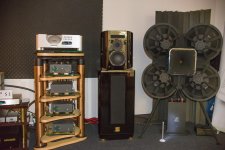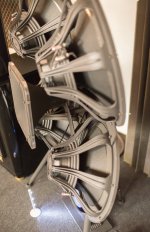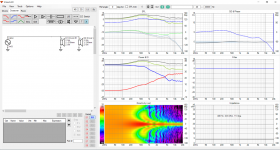Once i heard your inspiration. Walked away very impressed.
Stunning project!
Thanks for your report! Unfortunately, I didn't have the chance to listen Reflector audio, was inspired by photos. Happy that I went this way.
Hope, one day I'll have a big enough room for 4x18 per side 😀
Subscribed - what a brilliant idea. Perfect point source?
The Reflector Audio Lite is also very interesting, no photos of the innards of those though.
The Reflector Audio Lite is also very interesting, no photos of the innards of those though.
Last edited:
Subscribed - what a brilliant idea. Perfect point source?
Nothing perfect in this world, but... very close! 🙂
Unfortunately, I didn't have the chance to listen Reflector audio, was inspired by photos.
If i listened a lot to rock this could easily have been my perfect imagined sound. The unrestrained dynamics were just incredible.
Classical was not so much fun, but taking into account the class D amplification and dsp it would be unreasonable to expect more.
I would pay close attention to the off axis response of the woofers just below where they are crossed over to the CD+horn. With four woofers, the radiating area may be too wide to prevent beaming in the horizontal plane above about 500Hz (via my guesstimation). The two woofer version would not have this problem, or at least it would occur much higher in frequency. More woofers may not be "better" in this case.
I would expect this to be a really great system for its simplicity, as long as the crossover point to the horn is kept as low as possible, e.g. 700Hz. Integrating the woofers and the horn in this way into a 2-way hybrid dipole+directive-monopole system is clever. Nice work!
I would expect this to be a really great system for its simplicity, as long as the crossover point to the horn is kept as low as possible, e.g. 700Hz. Integrating the woofers and the horn in this way into a 2-way hybrid dipole+directive-monopole system is clever. Nice work!
If i listened a lot to rock this could easily have been my perfect imagined sound. The unrestrained dynamics were just incredible.
Classical was not so much fun, but taking into account the class D amplification and dsp it would be unreasonable to expect more.
In fact, you described the path I went through! First step — general sound concept, dynamics, room behavior etc. Then I switched to passive, so I could use a good DAC or experiment with amps. As a result, I am completely satisfied with the sound at any music.
I would pay close attention to the off axis response of the woofers just below where they are crossed over to the CD+horn. With four woofers, the radiating area may be too wide to prevent beaming in the horizontal plane above about 500Hz (via my guesstimation). The two woofer version would not have this problem, or at least it would occur much higher in frequency. More woofers may not be "better" in this case.
I would expect this to be a really great system for its simplicity, as long as the crossover point to the horn is kept as low as possible, e.g. 700Hz. Integrating the woofers and the horn in this way into a 2-way hybrid dipole+directive-monopole system is clever. Nice work!
I would like to listen to 4 woofers version, it might be fun regardless of directivity artifacts! But I agree that the 2 is more predictable and reasonable.
I have a plan to pull speaker out into the garden and take measurements, hope I can do it this summer. The room measurements of directivity not too valuable, they look good, but I'd like to check it out outdoor.
Sounds good. I would love to see your directivity measurements. You could model them, to a close approximation despite the "tilt" of the driver, using TheEdge (my favorite quick and dirty OB modeling app):
Tolvan Data
I have the parts to give this kind of system a try using two per side Eminence Deltalite 2515 (good up to and even above 1kHz on axis), a SEOS 18, and a DIYsoundgroup BA-750. I have been trying to design+build speakers that are 20-20k Hz dipoles, so it would be a great contrast to have this kind of system that is dipole only below 800Hz but still with controlled directivity at LF and "open" woofers.
Tolvan Data
I have the parts to give this kind of system a try using two per side Eminence Deltalite 2515 (good up to and even above 1kHz on axis), a SEOS 18, and a DIYsoundgroup BA-750. I have been trying to design+build speakers that are 20-20k Hz dipoles, so it would be a great contrast to have this kind of system that is dipole only below 800Hz but still with controlled directivity at LF and "open" woofers.
I'm not sure that outdoor measurements of such a system are valid. You lose all of the rear radiation. But who knows, you might learn something (or at least tick off your neighbors ;-)
I'm not sure that outdoor measurements of such a system are valid. You lose all of the rear radiation.
That's not true (at all). Do you think sound propagates only in a straight line or something? The front and rear are like two monopoles, and radiate spherically in all directions. So whether you are inside or outside, you will get contributions from both at the listening/mic location until you get to rather high frequency where the driver is very directional.
I would pay close attention to the off axis response of the woofers just below where they are crossed over to the CD+horn. With four woofers, the radiating area may be too wide to prevent beaming in the horizontal plane above about 500Hz (via my guesstimation). The two woofer version would not have this problem, or at least it would occur much higher in frequency. More woofers may not be "better" in this case.
I would expect this to be a really great system for its simplicity, as long as the crossover point to the horn is kept as low as possible, e.g. 700Hz. Integrating the woofers and the horn in this way into a 2-way hybrid dipole+directive-monopole system is clever. Nice work!
Taking into account that horn controls the directivity above 800 very well (and this is confirmed by independent measurements) - IMHO this is already half the case. Most important half 🙂
I have some doubts about the dipole peak area, so I want to make outdoor measurements. But I don't think the artifacts there spoil the picture too much. If they are, I will think about how to fix them.
Regarding the dipole / horn combination. I think it sounds very accurate at a crossover of <800. But I have an idea to try to implement something like Space Generators from AudioKinesis: take a horn tweeter with a narrow dispersion (40 degrees) and point it at the ceiling. This signal will come with a delay of >10 ms. Will not destroy the direct sound, but might enhance the sense of space. And it will complement the rear radiation of the midwoofers, better power response. Such a plan.
Last edited:
I'm not sure that outdoor measurements of such a system are valid. You lose all of the rear radiation. But who knows, you might learn something (or at least tick off your neighbors ;-)
After all, I'm interested in the sound in the area of my sofa 🙂 In this sense, I can live without "anechoic" measurements. But outdoor measurements will help to more accurately understand the behavior in the crossover area and the overall power response. At least, some fun for my neighbors! 😀
Two 18" drivers have pretty narrow vertical directivity, -6db off-axis response point is about half the frequency of the horizontal, ~350Hz. Quick try on VituixCAD sim and directivity index seems to shoot up to 10db at ~500Hz.
Ideally the horn would need to control directivity below this for smoother directivity index. I don't know if the bumpy power response and directivity there at mids is a problem but it is the same kind of effect that all MTM configurations have, just lower in frequency. Simplicity and relatively small size is the plus for this design and it probably sounds impressive but it is not anything revolutionary. Definitely not a point source unless the crossover was about 750Hz / 4 ~= 200Hz. Can't escape physics 😉
ps. I don't know how to sim ideal dipole speaker in vituixcad so this is just a demonstration that the vertical directivity is lot more tighter than horizontal with two woofers.
Ideally the horn would need to control directivity below this for smoother directivity index. I don't know if the bumpy power response and directivity there at mids is a problem but it is the same kind of effect that all MTM configurations have, just lower in frequency. Simplicity and relatively small size is the plus for this design and it probably sounds impressive but it is not anything revolutionary. Definitely not a point source unless the crossover was about 750Hz / 4 ~= 200Hz. Can't escape physics 😉
ps. I don't know how to sim ideal dipole speaker in vituixcad so this is just a demonstration that the vertical directivity is lot more tighter than horizontal with two woofers.
Attachments
Last edited:
Simplicity and relatively small size is the plus for this design and it probably sounds impressive but it is not anything revolutionary.
Sir, you flatter me, I'm not a revolutionary, I'm a humble hedonist! 😀
Definitely not a point source unless the crossover was about 750Hz / 4 ~= 200Hz. Can't escape physics 😉
Agree. But still, the source is quite symmetrical and it seems be good thing.
ps. I don't know how to sim ideal dipole speaker in vituixcad so this is just a demonstration that the vertical directivity is lot more tighter than horizontal with two woofers.
This seems pretty pre-determined even after simulating it in my head 🙂 The vertical directivity of both the horn and the 2x18 is moderately narrow (there is no problem when you gets up and sound disappears or becomes strange, it's just quieter), and wide enough to cover the entire sofa. I love it!
Two 18" drivers have pretty narrow vertical directivity, -6db off-axis response point is about half the frequency of the horizontal, ~350Hz. Quick try on VituixCAD sim and directivity index seems to shoot up to 10db at ~500Hz.
What you say is true, but the system can be elevated so that the horn is around ear height (e.g. 40 inches or 1m above the ground). This causes any/all seated listening locations to be very close to "on axis" in the vertical plane.
Compared to a boxed speaker, the dipole radiation pattern helps to reduce the directivity change from LF to HF and when elevated the system will have very little in terms of floor bounce effects.
Yeah, it would be interesting to see full polar measurements and in room response estimate in VituixCAD 🙂
What impact will this have on the validity of the measurement?You will lose some of the rear radiation depending on it's wavelength and directivity.
- Home
- Loudspeakers
- Multi-Way
- TIE Brute: open-baffle / horn speakers


